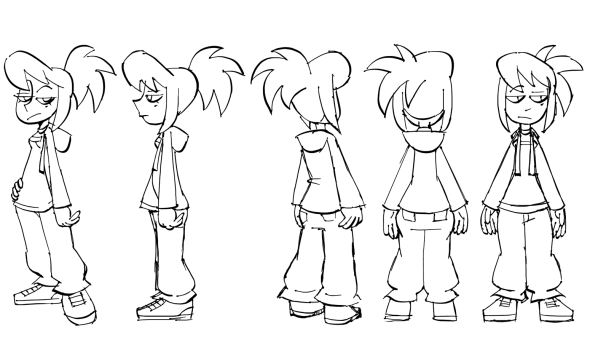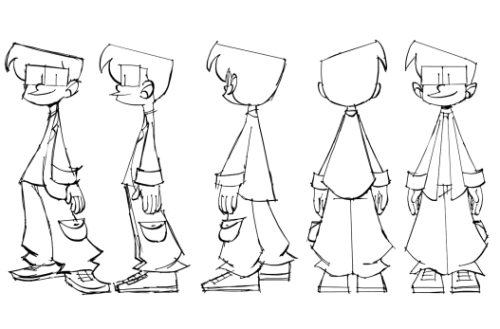In 2017, the television executive is a false deity. The people who once had the ultimate influence over the entertainment we indulge in have now become a mere afterthought to many. The film industry’s need for higher-ups has dropped greatly. Today, it is easier for anyone makes their own content without the stranglehold of a massive corporation backing you.
Independent projects can now employ artists in parts of the world where a market may not have existed before, and they give new creators in established markets a fighting chance.
That brings us to indie projects like Failing Upward, an upcoming animated sitcom created by NYU graduate Gary Trimarchi. The show follows JC and Cody; two best friends who attempt to have a long distance friendship after they switch living situations. JC moves back to the suburbs with her large family, whereas Cody moves to the city, moving from his parents’ house and into the real world.
The show found its funding opportunities through the crowdfunding website, Indiegogo, and within two months, raised enough money to produce six episodes. Also through the internet, Trimarchi and his animation partner, Nik Castaneda, have assembled a team of up-and-coming animators, working hard to bring this passion project to life. The team includes U.K., and New Jersey-based animators, Jack Bowlder, and Jamie Rodriguez — known for their animated shorts posted on Vimeo and YouTube; and Academy of Art University student, Natalie Butler, who does backgrounds on the show. Freelance artists, Wes Ennes, and Odyssey.com contributor, Ahmad Alami, are also on the show, doing storyboards and character design.
The tone of the show is very laid back and natural, allowing the characters time to just breathe. It feels like a love letter to the young adult animations of the 1990s, such as the ones from MTV, The WB, and Adult Swim. Think shows like Daria and Beavis & Butt-Head. The pacing is very mellowed out. In a culture dominated by in-your-face, fast-paced shows like Adventure Time and Spongebob, that may be hard for some to get used to. But I feel like it’s a welcomed change to the animation landscape.
I spoke with Trimarchi and voice actress Madeleine Morris over Skype and email to get a first-hand account of the show’s creative nature.

Where did the idea for this show come from? How did “Failing Upward” become what we now know it as?
GARY TRIMARCHI: I was in a class, and we had to do a project. For a final project — we built up to it all year — we had to either write the first 30 pages of a feature or a sitcom pilot. So I didn’t know what I wanted to do. I was up late watching Mission Hill, and some other shows that night, and I was like, “You know what? I’ve always wanted my own slice-of-life thing. Let me I give it a shot.” The main inspiration was that I had a friend at the time, who was very long distance, and I kind of started adapting it into these two characters meeting for the first time, then splitting off, and their lives after they had met. That kind of became Failing Upward.
MADELEINE MORRIS: The show has this sincerity and honesty to it. These are just young people with imaginations living their lives. The situations are universal. It’s so simple and charming! Less is more, and I think the setup is brilliant. Gary was adamant about communicating his vision for JC. While I was still in the audition process, we talked on the phone about who she is, where she is in life, how it affects her in the now, and her growth as the show progresses. The whole time I was thinking “I UNDERSTAND THIS, THIS WAS ME!!”

Since the show started off as a half-hour pilot script, what made you settle on doing shorter webisodes?
TRIMARCHI: I perfected the final draft of it for a comedy writing class. I was really proud of it. My professor really liked it, and she had some contacts at a cable network. I was 22 at the time, so it was crazy to hear that. She had a few stipulations, though. You know, “you have to take this out, you gotta take that out.” And I did all that. I wrote a draft that nobody is ever going to see with all that stuff taken out. And you can argue that it’s closer to what the final product is. But something was just off. The flow that I had laid out just wasn’t quite there. The one big thing she wanted to change was the ending. She didn’t want JC to move away, which is kind of the whole crux of the show.
From there, I wrote the pilot, and after, I sort of looked at it, and in my head, I was like, “Do I want to lose this, and potentially lose the rights to my characters?” So I contacted my professor and I said, “I really love this project, and I’m going to keep working on it from my own end and see where I get with it.” And she said, “OK, that’s not a problem.” The last thing I tried to do was that I met with the head of this online media company, and we had a lunch. I told him about the pilot, and he laid out what they were doing at the time. It didn’t go anywhere, but having that meeting with him, I thought about the pilot. I figured there had to be a way to do this. I looked at the core idea of the show, and it was these two characters on the phone. They only talk to each other, in person, in the pilot, and felt more like a sitcom. I said maybe we could do three-minute episodes where they’re talking on the phone. I ran with it from there.
It made me feel a lot more confident about what I was going to put out because, when you think about it, a 30-minute sitcom with two people on the phone is going to get very hectic and it’s going to kind of lose focus at points. The actions not quite as connected. When the main focus of the show is two people on the phone and that’s all it is, and it’s only three minutes, that’s a lot easier to relate to the characters and their situations. I like it a lot better. It feels like things are a lot more organized.

The show employs the talents of people such as freelance animators/illustrators Izzy Rae Brown, Nik Castaneda and others. How did the team come together?
TRIMARCHI: Well, first off, I met Izzy after I started doing a podcast that only lasted one episode. After that, I got an email from her, and she asked if I wanted to work together on it. She offered to do the title cards and other art. When that ended, I told her about Failing Upward, and she said we could probably do this in three-minute episodes. When I asked how much that would cost, she said that she could do it for free, which was incredibly gracious and super nice. She did the short for me, which is still up there (“Cody’s Pro Tips”). We started doing another short. She also did that for free, which is insane. That one was going to be JC centric.
Eventually, after a while it became clear that we had different aspirations; she wanted to focus on her time at the time, and I wanted to focus on Failing Upward. So, we decided to cut it off there and say ‘no harm, no foul’.
I was left without an animator. In the meantime, I was writing a new pilot for the web series. I wrote it, recorded it, and then Izzy cleaned it up. We were going to start getting into production with it. I didn’t want Izzy to have to do all the work, so one day, I was watching cartoons on YouTube, and I found Nik’s channel through a GameGrumps animation he did. I became a fan of Nik’s Mundane Little Life. He had this really cool voice — both figuratively and literally. I really liked his style, so I took a shot in the dark and contacted him over email. I sent him all the stuff, and he said sure. We kind of just went from there.
How has the show changed from the pilot, going into the series?
TRIMARCHI: Doing final touches to the scripts essentially turned into me retooling the entire show. I didn’t feel like I was saying enough to keep people invested. It just felt like two people talking on the phone. They’ll talk about their problems, but not enough about themselves, their actions and what they do, their environment. I feel like that’s the biggest part of the first five episodes– the way the characters react to the world around them, for better or worse.
The way we’ve split it up is that we have a cold open with one character, then the title sequence, a little section with the other character, and then they start talking. Then you have a finish-off sequence to the cold-open and a finish off section to the mid-section. Sometimes Cody’s the cold open, and J.C.’s the midsection, and vice versa. It’s not the formula for the entire show as a whole, but I think more or less what it is now.
I also feel like we are changing the style of it. We’re moving away from what Nik has done, more to Jack (lead animator) and Natalie’s (BG designer) style. It’s a more multifaceted show.
The show has people stationed all around the globe, from New Jersey to England. Having such a scattered staff sounds like it can easily lead the way for chaos to ensue. How does the collaboration work? How do you keep it all together?
TRIMARCHI: On the pilot with Nik, all our work was over Skype or Dropbox. Nik would send concept art, and we would scratch out two nights a week to work over Skype. Even as we were moving on and doing different things, we still always found a way to talk.
With the show, I just talk to everyone every week. I try to see where they are and what they’re doing. One of the hardest things thus far is making sure we’re on schedule. At the same time, I’ve seen so many people who rush their projects and come out with something less than stellar looking. So, if I have an artist come to me and ask for a bit more time on something, I try to be accommodating, while still sticking to a deadline.
MORRIS: I recorded the whole show in two sessions at Kocha Sound in Dallas. Gary and Brittany Lauda co-directed my first session (Gary Skyped in), and Brittany took the reins for the second once we understood how Gary wanted it to progress. Sometimes in play, the cast will record together in the same room. Since the cast for this show is nationwide, I did all my dialogue alone. That recording style doesn’t really allow for riffing, but we found some choice moments to be pretty vocally goofy. There’s a scene where we see JC as a teenager wearing headgear that cracks me up, and I don’t even know what it’s going to look like.
What would you say regarding the nature of crowdfunding and independent financing of projects?
MORRIS: Crowdfunding has been such a boon to independent artists looking to create, there are all sorts of projects that have received funding from places like Indiegogo and Kickstarter. There’s a market for everything, and it’s easier than ever to find it. Crowdfunding allows the contributor to be a part of this thing they love and believe in, and the smallest donation goes towards helping an artist create, learn, grow, provide, and eat.”
What do you hope to accomplish with the show? Where do you hope it goes? Do you want to go to TV? Do you want to do this half-season and move on?
TRIMARCHI: I think, for now, Failing Upward is going to continue it’s life, online. Perhaps, one day, I’ll expand it, I think that could be cool. If CN or Nick offered me a half-hour special, I’d lose my mind. I do eventually want to make the move to TV or even streaming services. I’ve actually been working on several animated pitches, some of which I’m really dedicated to fleshing out. Television has always been my favorite entertainment medium, so the goal is to certainly move towards that. That being said, as of now, I think Failing Upward presents me with a really great opportunity to learn some basics when it comes to spearheading a project. Youtube has really opened a lot of doors for content creators to cut their teeth, make mistakes, and cultivate a fanbase. I have three seasons planned. Twelve episodes each. I hope we can get to the end.
You can find “Failing Upward” on YouTube. Follow the show on Facebook, and don’t forget to check the show out when it premieres in May 2018.




Comments are closed.